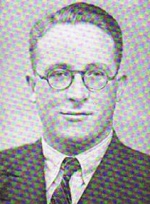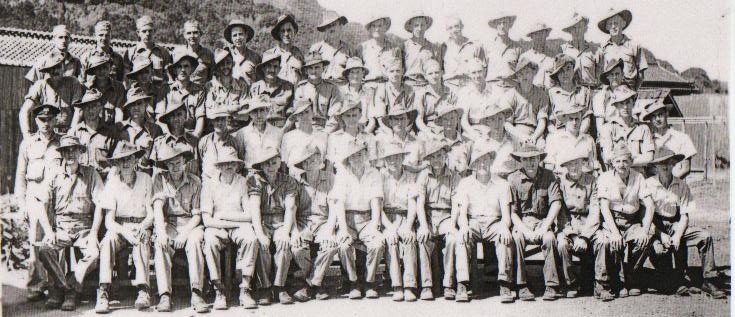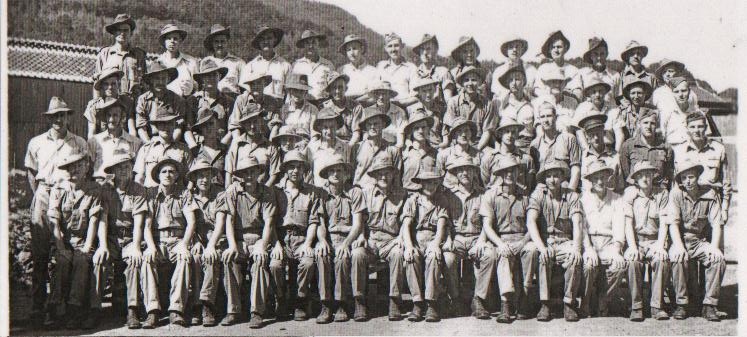 |
 |
![]()
| HIGGIN JOHN PERCIVAL CAPTAIN MEDICAL OFFICER NX34949 |
| 2/4 CASUALTY CLEARING STATION - ‘A’ FORCE BURMA THAILAND RAILWAY |
| – SENRYU CAMP, KYUSHU, JAPAN |
 John Higgin was born in Tamworth 4 April 1915. He studied medicine at Sydney University medical school and graduated in 1939. Others who graduated that year from Sydney University and subsequently became Prisoners of War of the Japanese were - D.J.Brennan, I.L.Duncan, D.N.Gillies, D.C.C.Hinder, R.M.Mills, C.R.B.Richards, and J.L.Taylor. Other POW doctors associated with the course as tutors etc were W.C.B. Cotter Harvey, W.A.Bye, G.F.S.Davies and W.E.Fisher.
John Higgin was born in Tamworth 4 April 1915. He studied medicine at Sydney University medical school and graduated in 1939. Others who graduated that year from Sydney University and subsequently became Prisoners of War of the Japanese were - D.J.Brennan, I.L.Duncan, D.N.Gillies, D.C.C.Hinder, R.M.Mills, C.R.B.Richards, and J.L.Taylor. Other POW doctors associated with the course as tutors etc were W.C.B. Cotter Harvey, W.A.Bye, G.F.S.Davies and W.E.Fisher.
The Senior Year Book of the Sydney University Medical School (year 1939) had the following picture and comments about John Higgin -
“Some five years ago the faculty was blessed by approximately thirteen stone of radiant health- John Percival Higgin- from Tamworth High. Whilst never confounding the examiners, he has always favourably impressed them.
His sporting activities include surfing and a game which he claims requires a golf course.
John is firmly of the belief that dehydration is the bane of human existence and to escape this spectre he occasionally varies his fluid intake. At such times he reveals a profound ecclesiastical understanding which we fear may yet lead him on to the straight and narrow.”
John Higgin enlisted in the Australian Imperial Force on 15 August 1940. He was allocated to the 2/4 Casualty Clearing Station (CCS). The unit was deployed to Malaya during 1941 and was heavily involved in providing medical support to the withdrawing allied troops.
In May 1942 John, as part of the medical team, mainly comprising 2/4 CCS Medical Officers, was shipped to Burma. Some reports indicate that he was landed at Victoria Point (as part of Green Force) along with Captain Claude Anderson (see “A Doctor’s War” by Rowley Richards). Claude Anderson recalls Captain A.J.M. (Alex) White also being at Victoria Point. This view was also supported by oral comments from the late Phil Beilby (2/4 Machine Gun Battalion).
It is clear that Captain Higgin was a medical officer in the 55 kilo hospital camp at the time that Lt Col Albert (later Sir Albert) Coates moved there from the 75 kilo camp. Prior to the arrival of Lt Col Coates, Higgin was caring for 1,200 patients as the only medical officer. He was very tired and overworked. Later 55 Kilo Camp (Khon Khan) had around 2,000 patients. Higgin must have assisted Lt Col Coates with some of the 120 amputations which were conducted in the most primitive conditions. It was around this time that a direction was given by Colonel Nagatomo that the three line medical officers i.e. those who were with the mobile teams, were to be switched with doctors who were back at the base/hospital camps. (It is likely that Brigadier Varley, advised by Lt Col Tom Hamilton (Senior Medical Officer “A” Force), influenced this decision). The switches were to rest the line doctors. Captain Higgin went to the 105 kilo camp in a swap with Captain Claude Anderson. Claude Anderson’s rest of 6 weeks was spent assisting Coates with about 60 of the amputations.
It is not clear exactly where Captain Higgin was for some time. (The same can be said of nearly all the Medical Officers on the Burma end of the line). However, I have stumbled across a chronology for the British (Sumatra) Battalion and it shows the following entries at Saigon in 1944.-
23 June. Brigadier Varley, Capts Sumner, Stewpart (sic) and Richards with 35 Kumi and part of 36 Kumi left for Singapore via Phnom-Penh.
26 June. Capts Moore, Higgins (sic) and Fleming with remainder of 40 Kumi and all 41 Kumi left en route Singapore…………
(I have assumed these officers were Australian with Fleming being a chaplain from “A” Force.)
I have been advised by Neil MacPherson (ex POW 2/2 Pioneer Battalion) that Higgin was the Medical Officer in his camp Senryu, Japan. They had travelled to Japan on the Awa Maru, which had left Singapore on the 26 December 1944 with 525 POWs. The ship arrived in Moji about 20 days later and the POWs were then split up into 3 different groups to become labour forces for Japanese industry. One of Higgin’s assistants in that camp was Able Seaman Charlie Goodchap, who was a survivor of the sinking of the HMAS Perth in the Sunda Straits in 1942. Charlie advised me they had no drugs and few instruments. Patients would be taken to a Jap hospital if there was anything other than the basic to be dealt with. Higgin was not permitted to accompany the patient.
A reference to John Higgin appears in the book “The Rising Sun, The decline and Fall of the Japanese Empire 1936-1945” by John Toland. In p 997 of Vol 11 there is reference to the dropping of the atomic bomb on Nagasaki. The quote says “There was a deep rumble, followed by a blast of air. The earth trembled. Within moments there was another tremor, and an Australian Physician Dr John Higgin remarked, “This must be the beginning of a great naval barrage” the shock waves and tremors continued for almost five minutes.” The source for the quote could possibly have been an American doctor Julian M Goodman who was in Senryu camp 40 miles from the epicentre at Nagasaki. (My thanks to Group Captain Retired (Doctor) Mike Galvin for bringing the reference to my attention and encouraging me to finally tackle the story of Captain John Higgin- another unsung hero POW Medical Officer.)
Captain John Higgin was commonly known as “Cyclops” by his fellow POWs, this being a reference to the thick lenses of his glasses. See below picture taken shortly after the Japanese capitulated 15 August 1945. Captain Higgin is second from the left in the second row. Neil MacPherson is second from the left in the fourth (back) row.

In the following picture Charlie Goodchap is fourth from the left in the second row

I am informed that Doctor Higgin resumed medical practice in Bathurst after the War. No other details are known of his life.
Ex POW Neil MacPherson when viewing the final draft of this article said “The… story of Captain Higgin which is long overdue, is a tribute to a great doctor and a great man”.
Article written by Lt Col Retired Peter Winstanley OAM RFD.
Email peterwinstanley@bigpond.com . The assistance of ex POWs Neil MacPherson 2/2 Pioneer Battalion and Charlie Goodchap HMAS Perth, together with the reference from Mike Galvin, is acknowledged. Reference was made to the following books- “A Doctor’s War” by Rowley Richards (printed 2005 and presently available in books shops). “The Survival Factor” by Rowley Richards and Maria McEwen. “Behind Bamboo” by Rohan Rivett. “Blue Hayes” by Leslie Hall. “The Burma-Thailand Railway of Death” by E.R. (Bon) Hall.
|
|